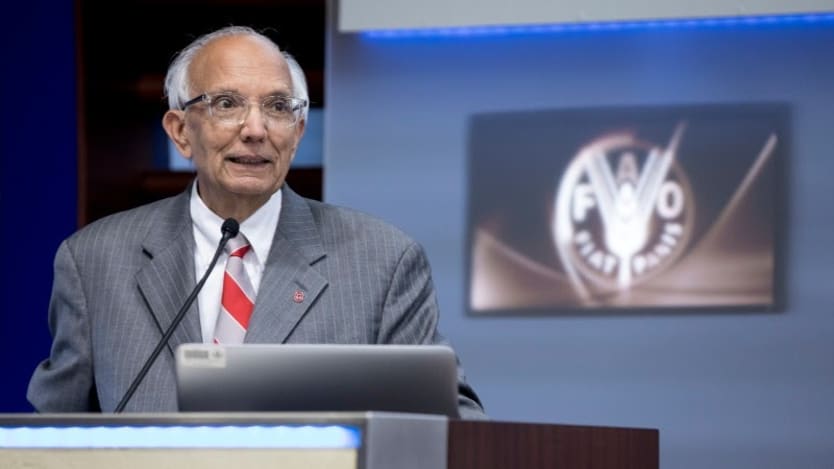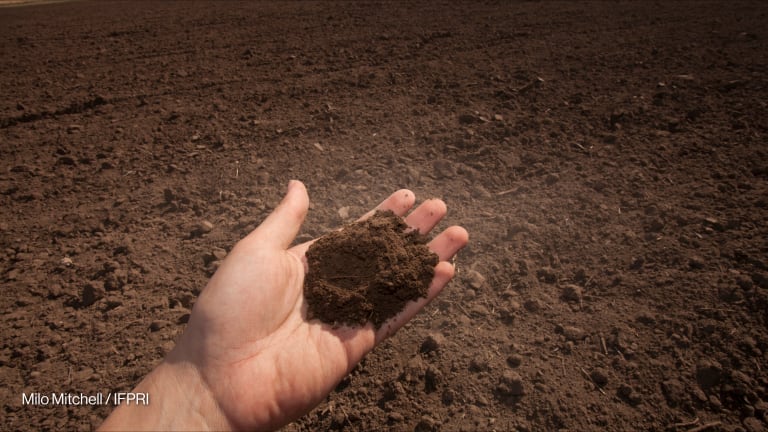
WASHINGTON — Soil scientist Rattan Lal remembers the moment in 1984 when he realized soil could play a key role in reversing global warming.
A visit from another scientist to his field experiment on carbon levels in soil at the International Institute of Tropical Agriculture in Nigeria led to a conversation about where the carbon in cultivated agricultural land went when it disappeared. Lal had initially been operating under the assumption that most gets absorbed into bodies of water, but he realized carbon was also getting absorbed into the atmosphere.
“If soil is a living thing then it must have a right like any other living thing has. That means soil must be protected. Soil must be restored. Soil must be managed properly and judiciously.”
— Rattan Lal, 2020 World Food Prize laureate“As soil loses its carbon, its ability to provide the ecosystem services deteriorates,” Lal said. “As I came to the U.S., my focus entirely shifted to making soil agriculture as a sink of atmospheric CO2 by reversing the trend and seeing how much sink capacity it could have. I started looking at the rate at which carbon can be put back and what practices there are and how can we encourage farmers to do it globally.”
Lal, who grew up in India, is the 2020 World Food Prize laureate in recognition of his work to link increased food production to natural resource conservation and climate change mitigation through a better understanding of soil. Now a professor of soil science and founding director of the Carbon Management and Sequestration Center at The Ohio State University, Lal has conducted research on restoring soil health in Africa, Asia, and Latin America.
'Google Maps for food systems': New dashboard aims to aid decision-making
The Food Systems Dashboard aggregates data on 171 indicators in 230 countries to identify where food systems may be malfunctioning so that aid policymakers can fix them.
Ahead of his announcement as the 2020 laureate, Lal spoke with Devex about how his 40-year career has helped increase agricultural yields and why policymakers must focus on soil health if they want to solve problems with the global food system.
This conversation has been edited for length and clarity.
Why is soil health a fundamental part of the food system?
Ninety-five percent of the food that we consume globally comes from soil. Agriculture is becoming more important. If anything happened to soil productivity and functionality, that impacts all ecosystem services that are provisioned by soil. There are many ecosystem services: food quantity, food quality, nutrition quality, food safety, water quality, water renewability, transport of pollutants — chemicals from soil to water — air quality. Soil is the major source of greenhouse gases that cause global warming. My research has been focused on how to make soil a sink of adverse carbon dioxide and methane, rather than a source.
My philosophy has been that the health of soil, plants, animals, people, and the environment are interconnected. I also believe that soil degradation, which is a rampant problem in developing countries because of land misuse or mismanagement, is a cause of people displacement and desperateness, migration. Global peace and tranquility really depend on soil health as well. That realization is not very widely appreciated.
“By improving soil health, we can produce more and more from less and less.”
—How do you ensure policymakers understand this connection?
I was interviewed to be a science adviser for Secretary of State John Kerry. I never made it, but I had an interest in it because I believe that translating science into action requires somebody like a science adviser to the secretary or the president, to policymakers, to help that happen. I did become a science adviser to the former secretary of the environment of Germany.
I think there’s a global realization by the policymakers that there’s a need to change direction and make agriculture a solution, and it has to be, because we can’t do without agriculture. Agriculture has to be a solution. I’m very positive that this movement is going to continue. Whether we look at food security, nutrition security, global warming, water quality, drought-food syndrome, biodiversity — the solution lies in the better management of soil health. That message policymakers must get.
Soil is a living thing. That’s what soil health means. Health implies living things: health of animals, health of people, health of soil. If soil is a living thing then it must have a right like any other living thing has. That means soil must be protected. Soil must be restored. Soil must be managed properly and judiciously.
How does soil health influence yield on agricultural lands?
Soil health determines the productive capacity of any agricultural practice. Let’s take an example: 70% of global water use is in agriculture, most of it by irrigation. We can save a lot of water if the efficiency of irrigation can be improved, and water holding capacity is dependent on soil health. Soil has to determine use efficiencies of input and productive capacity.
If we have extreme climate events, healthy soil is more resilient, just like healthy people are more resilient against any virus or pandemic. The health of soil determines the ability of the soil to sustain production. Most of the agricultural soil — especially in developing countries, about one-third of the total land area — is affected by adverse degradation processes such as erosion by water and wind. The Dust Bowl of the 1930s in the U.S. was an example of that.
If we can reduce the emission of methane and nitrous oxide for better soil health, we also mitigate climate change. The pandemic reduced nitrous oxide concentration in many major international cities in Europe by 40%. So it can be done.
How does soil health influence our ability to feed the earth’s growing population in a sustainable way?
We can improve the quantity of the food. When soil is degraded and it does not have an ample supply of micronutrients, then the food produced from that soil is also deficient in them and deficient in protein.
There’s a strong link between health of soil, health of plants, health of animals, health of people — because they are dependent on plants and animals — and health of the environment. Quality of water, air, and soil together. This is a continuous chain. When soil degrades, its health deteriorates, the health of plants, animal, people, environment deteriorates with it. Therefore having plenty of laws that protect soil health is really very critical.
Q&A: New UN guidelines target 'out of whack' food systems
The U.N. Committee on Food Security will release voluntary guidelines that recommend policy change to better address food systems and nutrition challenges.
By improving soil health, we can produce more and more from less and less: less land, less water, less fertilizer, less pesticides, less environmental damage, less emission of greenhouse gases.
Globally we produce our full 3 billion tons of grain on 700 million hectares of land area. By 2050 it should be about 600 million hectare — not going up, going down. By 2100, it should come down to about 500 million hectares. Not only producing more from less by improving productivity, but also by less waste. We waste 30% of the food even in the United States. Food waste is a crime against nature.
How does food waste relate to soil health?
A lot of land area, a lot of energy, a lot water, a lot of fertilizer goes into food production and then we waste. And then when it goes to the landfill it emits greenhouse gases, methane, and nitrous oxide. It’s really a triple jeopardy.
Food waste is really a serious problem globally. We should not focus so much on producing more, we should respect and preserve and use safely and judiciously the food. In many cultures — I grew up in Hinduism — food is worshipped as a god. How can I waste it? We must never waste food.
The only place in the universe where death is resurrected into life is the interface of soil and plant roots. The decomposing biomass of any living thing becomes nutrients, and plants take them up and start the life all over again. Soil is the life-giving entity.








